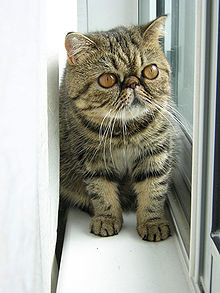The Exotic Shorthair Cat
One of the breeds of cat that is growing increasingly popular is the Exotic Shorthair Cat. The breed came to be by breeding a hybridization of British Shorthair and the American shorthair with the Persians (so American/British Shorthair + Persian = Exotic Shorthair).
Looks and colors of exotic shorthair cats can be all over the map. But they certainly can have the complexion of Persian cat but with the hair short. This gives the cat stocky build and short thick hair. It is the best of both worlds of their This was done on the occasion of adding short hair gene pool of genes Persian. It is accepted as pure race since 1967 , when they competed in the championship May 1.
The exotic shorthair or simply “exotic” is a breed of cats native to the United States . Legend is that the breed came into being from an attempt to improve the shorthair. The exotic shorthear is though to have been breed successfully in the 1950s by American breeders. It wasn’t until the 1960’s that the breed was recognized. It really can be very similar to the short hair Persian cat. It shares its curvy profile and crushed face with that of a Persian. All colors and color patterns are seen with this breed, and most federations allow crosses with Persian.
While the exotic does not enjoy the popularity of Persian cat , this breed has spread rapidly thanks to shorter hair and their care is less complicated. Also many own the cat due to lower amount of cat hair in the home and therefore fewer allergies symptoms with those with allergies.
During the hybridization program also crosses were made with the Russian Blue and the Burmese . Since 1987 only be crossed with Persian cat . The Fédération Internationale Féline recognized the Exotic Shorthair cat in 1986.
Features of the Exotic Shorthair Cat
The exotic shorthair cat has a compact design, rounded body, stocky, with short, thick hair. They normally have big round eyes, short snub nose, sweet facial expression, and small ears give you a great look.
General Description the Exotic Shorthair
- Head:
Round and solid. broad skull. Rounded front. round and full cheeks. Morro wide and round. short and wide, pronounced nose. strong chin. Wide and powerful jaws.
- Ears:
Small, rounded at the tip, not too open at the base. Widely spaced and well furred inside.
- eyes :
Large, round and well separated.
- neck :
Short and thick.
- body :
Medium size. broad chest, massive shoulders. Large and powerful muscles bones. Weight: 3.5-6 kg.
- leg :
Short, straight and large. Round legs, large. Flakes hair between the toes are desirable.
- Cola :
Short, thick, carried low. rounded tip.
- hair :
short hair, but a little longer than other short-haired breeds. Denso, and erect fluffy hair.
Character of the Exotic ShortHair
The exotic cat has a soft and calm personality very similar to that of the Persians, but it is more spunky and lively. Most of the Exotics (raised properly) are playful, they are amiable with other dogs and cats, and are know for their curiosity. The exotic shorthair rarely meows. The breed seems to general not like being alone, and needs the presence of its owner. They tend to show more affection and loyalty than most breeds.
In February 2007 it was legally constituted the Latin American Association of Cat Exotic who as an organization seeking to boost the fans in Latin America, responsible breeding and holding of the feline race.
Attention and Grooming of Shorthairs
The Exotic can keep their own fur tidy with little human assistance (unlike their cousins the Persians). Though weekly brushing and grooming is recommended to remove loose hair and reduce shedding and hairballs.
Similarly with other flat-faced pets, the Exotic’s tear system are prone to be plugged because of the nasolacrimal duct, which can dampen and cause discoloration of the eye. This can be relieved by periodically cleaning the cat’s face with a cloth moistened with water or one of the commercial preparations made expressly for this goal.
This breed ages very slowly, and generally will not reach maturity until around two years after birth. The puberty stage is much later than other breeds. On occasion, when two Spectacular Shorthairs are crossed, they may produce long-haired cats called “Exotic Longhairs” by the CFA. Externally, they look like Persians.
Wellness of ShortHairs
Because of safeguards used by early dog breeders, the Exotic Shorthair is not typically prone to disease or genetic malocclusions (misalignment of teeth). The cat is a brachycephalous breed, which means that the problems result from getting the nose and eyes next to each other, supplying the appearance of a pushed-in face. As well as difficulties with the tear ducts, sinus problems can also occur. Thanks to the shortened mouth, we have a chance of dental misalignment or tooth crowding.

Brachycephalic airway problem (BAS). Often known as brachycephalic respiratory system syndrome or congenital obstructive upper airway disease, ÉPHÉMÈRE causes upper airway malocclusions ranging in severity. The syndrome can cause increased airway resistance, inflammation of structures in the breathing passages, and increased strain on the heart. Treatment includes weight reduction, surgery, and avoiding wetter or hot conditions.
Calcium supplement Oxalate Urolithiasis. A natural stone that crystallizes in the bladder and kidney.
Dystocia. An abnormal labor credited to large-domed skulls.
Feline polycystic kidney disease (PKD) can we a problem with exotics. Exotic Shorthairs, as well as Persians and other Persian-derived cats, have a high potential for getting PKD, a disease that can lead to renal failure. Several studies using ultrasound scan screening have shown that the occurrance of PKD in Exotics is between 40-50% in developed nations. DNA screening process for PKD highly recommended for all Exotic cats found in breeding programs to reduce the incidence of renal disease by spaying and neutering PKD positive pet cats.
